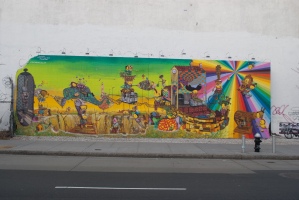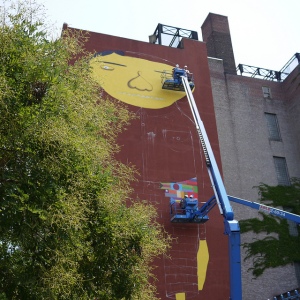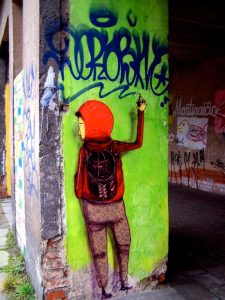About this time last year, I sat down and made a list of all the art sites that I had always heard about but had never visited in the Lower East Side in downtown NYC. I had mentioned it to my friend Ryan, who graciously agreed to accompany me and take pictures. And so, I, armed with my pen and notebook, and he, armed with his camera bag, set out one chilly morning to go on a quest to see and capture as much street art as we possibly could during the few hours of daylight that were available to us. We wandered on foot through much of Chelsea, SoHo, and down Wooster Street, making stops at a number of small contemporary art galleries and alternative exhibition spaces (including Deitch Projects, Woodward Gallery, and 112 Greene Street), stopping to take pictures of any interesting stickers, tags, and murals that caught our attention along the way. The Os Gêmeos mural on the corner of Houston and Bowery was one of our last stops, and by the time we reached it, we were tired, cold, and possibly hungry. However, even the act of walking towards it was a revitalizing one.
When I first returned to NYC after graduating university, one of the first pieces that I was excited to see was the Deitch wall on Houston and Bowery, which at that time was painted with a fantastic mural by Os Gêmeos. Os Gêmeos (Portuguese for “the Twins”) is a Brazilian duo consisting of identical twin brothers Otavio and Gustavo Pandolfo (b. 1974). On the streets, they’ve created giant figures several stories tall, drawn life-sized characters engaged in everyday activities such as hugging each other or writing graff, and have spun detailed narratives populated with their characters inside sprawling muralscapes. In the gallery, they create everything from paintings to sound-system installations to giant interactive sculptures. Together, they have helped to define the visual landscape of São Paolo and their unique visual language has become internationally synonymous with Brazilian street art.
Back in 2009, I had seen the pictures of the wall that they had recently completed, but nothing could prepare me for seeing it up close. Those of you who’ve been to the Deitch wall on the corner of Houston and Bowery will know that there’s nothing too much to see in that general area. A sea of grey concrete, some fences, and drab and dilapidated buildings are really all that line the wide street. After seeing it from afar, so starkly juxtaposing its bland surroundings, the sheer act of walking towards it was like walking towards an oasis of color and movement. We must have spent nearly half an hour at the wall, me taking notes and Ryan snapping dozens of pictures. Perhaps it was the girl laying on the back of a whale with a serene smile on her face as she slowly dissolved into bubbles and drifted up into the atmosphere. Perhaps it was the boy laughing as he playfully leaned over the edge of the waterfall, holding onto a fish for support. Perhaps it was the figure with the outstretched arms who served as the mast of the boat perched atop the N Train (and looked like he was travelling down the tracks to give you, the viewer, a great big hug). Or, perhaps it was how they all came together to seamlessly populate the wall, but after quietly contemplating each character and each scene of the mural both individually and as a cohesive unit (with a slightly bemused smile on my face, I’m sure), I knew that I wanted to learn all I could about the creators of this extraordinarily vibrant landscape.
What all Os Gêmeos works have in common is that even from a distance their work is very distinguishable as Os Gêmeos creations. Much like mural they completed on Bowery and Houston back in 2009, their work tends to be both colorful and fantastical, and is inhabited by thick yellow people with matchstick-thin limbs and angular, expressive eyes that are set widely apart. Each piece they do holds some sort of commentary on love, hope, poverty, or political dissent. Their murals are so detailed and filled with movement that they will almost make you dizzy. But there is no doubt that you won’t want to look away for regret of missing something. Still, you could look at one for hours and still only pick up a fraction of the details and a fraction of the narrative that the Pandolfo brothers have illustrated for you to see.
Originally the Pandolfo brothers were break dancers who were greatly influenced by the New York City hip hop culture of the 1970s (which hit Brazil in the mid-1980s). Although they had been using latex and rollers to tag their names, by 1988, they had made the leap into street art. As they started to mature as street artists they drew upon their experiences as well as local styles such as Brazilian folk art and pixação (a cryptic straight-letter style of building writing unique to São Paolo that is associated with heavy metal and the disenfranchised lower class). However, the Pandolfo twins had began developing their visual language together in shared sketchbooks as children as early as the age of 4, creating and capturing a brightly colored world shared in their dreams that they call “Tritrez.”
Their works simultaneously evoke the world of their dreams and the favelas (ghetto) in which they were raised. In this sense, both pixação and Os Gêmeos draw upon the same political and social discontent felt by much of the population in São Paolo. However, Os Gêmeos also strive to represent their culture, the beauty of Brazil, and the positive aspects of Brazilian family life, and through their vibrant images, hope to add color to and enhance everyday life. This makes their world and the characters who inhabit it just as complex and exciting to follow as those found in any well-written story. Familial love, national pride, and the desire to precipitate change are represented with equal importance as political unrest and extreme poverty throughout each of their works. Perhaps this is why, almost unanimously, viewers are attracted to their work.
Their method of painting is just as unique as the world they’ve created. They are adamant about painting only during the day in extremely public areas. When they paint a mural, the Pandolfo twins plan the visual story before they start drawing on the wall. Each twin starts at one end and they continue to paint until they meet in the middle. It is a very intuitive process between the brothers because no talking is involved.
Although Os Gêmeos continue to paint in São Paolo to this day (both sanctioned and unsanctioned works), since their first show in the United States in San Francisco’s The Luggage Store in 2003, they have been extremely busy with legitimate work outside of Brazil as well. Os Gêmeos have painted frequently in NYC, including a large mural in 2005 in Coney Island. They’ve participated in several collaborations with Deitch Projects in NYC, including a show in 2005, the Armory Show in 2006, a show in 2008, and the aforementioned mural in 2009 (which remained up for a year). This past summer, they returned to NYC to paint one of their iconic figures onto the side of P.S. 11 in downtown Chelsea in collaboration with Futura2000 (an internationally acclaimed street artist who got his start bombing subway cars in NYC in the 1970s and pioneered abstract street art). Most recently, Os Gêmeos returned to Maimi Beach to take part in Art Basel (a Deitch-sponsored project in which they also participated in 2005).
They’ve been huge on the West Coast, in Cuba, and in Europe as well. Over the past few years, they’ve painted in Portugal, Germany, Holland, Lithuania, and the UK (including the Kelburn Castle in Glasgow in 2007). In 2008, Os Gêmeos was invited to create a mural for Tate Modern Gallery in London as part of a larger exhibition of street art on the façade of their building. Hailed as the first major display of street art at a public museum in London, it led to a significant re-evaluation of their work by their native city of São Paolo.
Two years prior to the exhibition, Mayor Gilberto Kassab of São Paulo introduced the “Cidade Limpa” (Clean City) law aimed at eliminating all forms of what he calls “visual pollution.” This official clean-up campaign led to many sanctioned images being lost or irreparably damaged. Because there were no official objective guidelines given other than to paint over anything “irregular,” much of the works are judged subjectively. Following the exhibition in 2008, a 680 meter long mural painted by Os Gêmeos, Nunca, and Nina Pandolfo (Otavio’s wife) on retaining walls along the 23 de Maio expressway was half-obliterated with gray paint (despite having been officially sanctioned public art).
This effort by São Paulo is a cross between New York City’s graffiti reform of the 80s and 90s and the efforts Grey Ghost, an anti-graffiti vigilante in New Orleans (LA) who white-washed many great pieces of street art out of existence between 1997 and 2008. Former New York City mayor Ed Koch’s vigorous subscription to the broken window theory promoted an aggressive anti-graffiti campaign in New York in the early eighties, resulting in a strenuous zero tolerance policy ever since. In 1995 Mayor Rudolph Giuliani of New York set up the Anti-Graffiti Task Force, a multi-agency initiative to combat graffiti vandalism in New York City. In terms of the introduction of this legislation, São Paulo is echoing the political reform that took place across the U.S. a decade earlier. However, because of the subjective nature of these laws, the real parallel can be drawn between the Cidade Limpa laws and the work of New Orleans-based vigilante Grey Ghost and his non-profit organization Operation: Clean Sweep.
The Grey Ghost, also known as Fred Radtke, has been painting over street art in New Orleans under the cover of darkness with gray paint since 1997. Known by the signature grey smear of paint his rollers left in the stead of tags and art alike, his works had long been the cause of contentious debate within the New Orleans community. But, that is another story for another day. You see, in 2008, tensions with the street-art loving community in New Orleans peaked when the Grey Ghost painted over a newly-completed mural on Burgundy and Press Streets. Much like the mural along the 23 de Maio expressway, the mural on Burgundy and Press Streets shared many of the characteristics with graffiti. However, there was one important distinction: the artists had gotten permission to paint it.
Since its inception, graffiti and murals have been misunderstood and underappreciated forms of art. Within the past few years, it has slowly begun to gain appreciation from institutions world-wide. Deitch and the Tate Modern are some of the many renowned institutions that have legitimized not only the work of Os Gêmeos, but other street artists as well. This appreciation has started to affect the way street art is viewed by not only the general populace, but the government (and although there is still a firm divide between those who whole-heartedly support street and those who lump it in with mindless tagging, there is a raised awareness). In São Paulo, this newfound recognition abroad of Os Gêmeos’ work stimulated a public discussion of what constituted art, and the creation of a registry of sanctioned street art in São Paulo was established by the city for preservation.
Although Os Gêmeos have said multiple times that they take things day by day, I, for one, cannot wait to see what the future holds for these immensely talented grafiteiros. You, too, can keep tabs on them via their website (which although in Portuguese has enough pictures so that visitors of any language can appreciate it). Definitely keep your eyes out for what seems to be their next project: a full-length animation (the teaser was released in September)!
For more insight into Os Gêmeos, here are two great interviews from 2000 and 2003 which have been translated into English and here’s a recent one from STYLEFILE, a graffiti magazine. If you want to read more about the mural on Bowery and Houston, Roberta Smith of the New York Times did a great review wrote a wonderfully detailed description in her review. However, a picture says a thousand words, so again, I would like to extend a very special thanks to my friend, Ryan, who braved the cold with his massive bag of camera equipment to take such beautiful pictures of the Os Gêmeos mural in the Bowery on our epic street art adventure last year. Pictures other than the Bowery were taken from various places around the internet. There is no shortage of Os Gêmeos pictures, so just Google images if you want to see more!











I’m interesting in understanding the concept of graffiti as an urban art. I’m trying to creat a concept in Colombia, Medellin my city to help express the kids dreams and ideas.
Great report! I´ve never seen someone exhplaning so right about their importance in São Paulo. Even new street artists don´t know that. Congratulations!
Fantastic, interesting really well written! Thanks